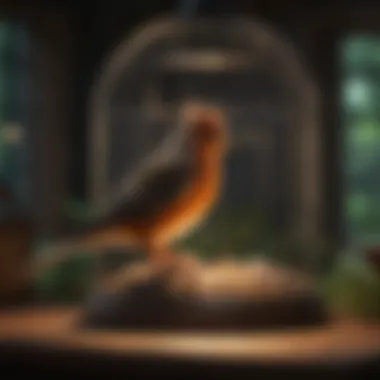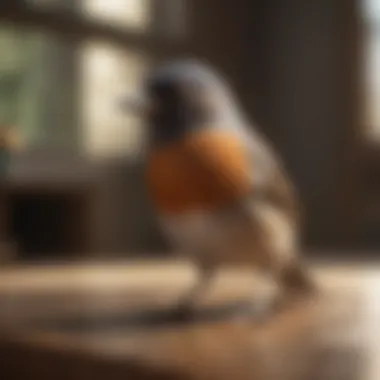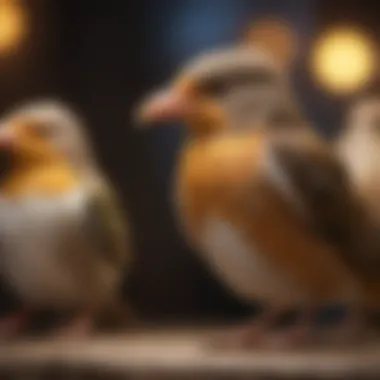Full Spectrum Light Bulbs for Birds: A Comprehensive Guide


Intro
A well-lit environment is crucial for the health of pet birds. Just as humans benefit from exposure to natural sunlight, birds require appropriate lighting to thrive. The introduction of full spectrum light bulbs has significantly impacted avian care. These bulbs closely resemble sunlight, fulfilling various behavioral and physiological needs of birds. This article explains the importance of full spectrum lighting for avian health and covers practical applications for pet owners.
Understanding Your Pet
Pet Behavior Basics
Birds are highly social creatures. They engage in diverse forms of communication, whether it’s chirping, preening, or engaging in playful behavior. Understanding these basics is essential for any bird owner. Full spectrum light bulbs can influence their mood and activity levels, promoting a more vibrant behavior. Regular exposure to these lights mimics day-night cycles, helping birds maintain a natural rhythm.
Common Breed Characteristics
Different bird species exhibit varied characteristics. For instance, parrots are known for their intelligence and social needs, while canaries enjoy quiet personal time. Understanding these traits is crucial when considering lighting needs. Not all birds react the same way to light. An African grey parrot's vibrant personality may flourish better under specific lighting conditions compared to a less active finch.
Species-Specific Needs
It is vital to acknowledge the specific needs of each bird species. Some birds require more intense light sources to facilitate feather growth, while others need softer illumination for rest. The availability of full spectrum bulbs allows for personalized care based on individual species requirements. This not only enhances their well-being but also contributes to a healthier environment.
Light and Health
Exposure to natural light is linked to important processes in birds, including mood stabilization, mating rituals, and feather growth. Full spectrum light bulbs can be particularly beneficial during winter months when natural sunlight is limited. They help prevent conditions like feather plucking or depression that can arise due to insufficient lighting.
"Providing adequate lighting allows birds to express their natural behaviors, leading to happier and healthier lives."
Choosing the Right Bulbs
When selecting full spectrum light bulbs, consider the following:
- Light Intensity: Different bird species have various light intensity needs.
- UVB Emission: Look for bulbs that emit UVB, as this is crucial for Vitamin D synthesis in birds.
- Color Temperature: Bulbs with a color temperature of around 5000K are ideal, mimicking midday sun.
It is advisable to consult with avian veterinarians to identify the best options for specific species.
Practical Applications
Integrating full spectrum light into a bird’s habitat can be achieved through various methods:
- Desk Lamps: Setting a lamp with a full spectrum bulb in the bird’s area can enhance their lighting.
- Ceiling Fixtures: For larger setups, ceiling fixtures can provide an even distribution of light.
- Lighting Timers: Use timers to ensure a regular cycle that mimics natural daylight hours.
Monitoring the bird’s behavior after switching to full spectrum light can provide valuable insights into their well-being and happiness.
Understanding Full Spectrum Light
Full spectrum light is crucial for the health and well-being of birds kept in captivity. This type of lighting closely mimics the natural sunlight that birds are adapted to in the wild. It plays a role in their behavior, mood, and overall physiological health. By understanding full spectrum light, pet owners can create an environment that meets their birds' needs.
Definition and Characteristics
Full spectrum light encompasses a range of wavelengths, including visible light and UV radiation. The primary characteristic of full spectrum bulbs is their ability to produce light across the entire visible spectrum, along with UVA and UVB light. The presence of these wavelengths can help in the synthesis of vitamin D, which is vital for calcium metabolism in birds. Unlike standard light bulbs, full spectrum lights provide a more balanced light that supports avian natural behaviors.
Types of Light Bulbs
Incandescent


Incandescent bulbs are traditional light sources that emit a warm light. They are known for their affordability and easy availability. These bulbs produce some UV radiation, but much less compared to full spectrum options. Their key characteristic is the warm color temperature, which can create a cozy atmosphere. However, incandescent bulbs are not the most energy-efficient option, and their limited UV output makes them less beneficial for birds that require full spectrum lighting.
CFL
Compact Fluorescent Lamps (CFL) are a popular choice due to their energy efficiency. They use less electricity than incandescent bulbs and last longer, making them a cost-effective solution. A key characteristic of CFLs is their ability to produce cooler color temperatures. Some CFL bulbs are marketed as full spectrum and can provide adequate UV exposure for birds. However, they may not offer the same light quality as LED options and can take time to reach full brightness.
LED
LED bulbs are increasingly favored for their longevity and energy efficiency. They emit minimal heat and have a longer lifespan, which reduces frequent replacement needs. A standout feature of LED bulbs is their flexibility in color temperature and spectrum production. High-quality LED options specifically designed for birds can provide both UVA and UVB light, supporting overall health. They are generally more cost-effective in the long run despite a higher initial price point.
UV Radiation and Birds
Importance of UVB
UVB radiation is essential for birds as it stimulates the production of vitamin D3 in their skin. This is important for calcium absorption, which is crucial for bone health and egg production. A key benefit of providing UVB light is that it closely approximates natural sunlight conditions, allowing birds to engage in necessary behaviors like sunbathing. It is important to ensure that bulbs providing UVB are positioned correctly to maximize exposure.
Effects of UVA
UVA rays also play a significant role in avian health. These rays affect birds' behavior and perception of their environment. The key characteristic of UVA is its ability to enhance visual perception; birds can see UV light, which is invisible to humans. This aids their foraging and social interactions. Providing UVA light can lead to more natural behaviors and improve overall well-being. However, excessive exposure should be avoided to prevent potential harm.
The Role of Light in Avian Health
The significance of light in promoting the health of birds cannot be overstated. Adequate lighting is essential for their well-being, affecting multiple dimensions of their lives. Avian health is fundamentally linked to the natural rhythms of light, which influences behavioral patterns, biological functions, and overall vitality. Given that many pet birds live in controlled environments, understanding how to replicate natural light conditions is crucial. Full spectrum light bulbs, in particular, have emerged as an effective solution to address these needs.
Circadian Rhythms in Birds
Circadian rhythms in birds are internal processes that follow a roughly 24-hour cycle, responding primarily to light and darkness. These rhythms regulate sleep-wake cycles, feeding times, and other behavioral patterns. Natural sunlight triggers these rhythms, promoting healthy physiological functions. When birds are exposed to full spectrum lighting that simulates sunlight, it helps regulate their biological clock, ensuring they remain in sync with day and night cycles. This regulation contributes to better mental well-being and reduces stress-related behaviors, which are common in birds kept indoors.
Behavioral Impacts
Activity Levels
Activity levels signify a bird's physical engagement throughout the day. It is a crucial aspect of their overall health, as active birds are generally healthier and more interactive. The presence of full spectrum lighting encourages birds to be more active, mimicking the high energy they would exhibit in natural daylight. When birds receive adequate light, they are likely to engage in more exploratory behavior, flying, and playing. This heightened activity not only aids in physical fitness but also fosters mental stimulation, significantly helping to prevent boredom and related behavioral issues.
Breeding Behavior
Breeding behavior is another key aspect influenced by light. Proper lighting setups can stimulate hormonal changes that promote mating activities among pet birds. Full spectrum light bulbs mimic the longer daylight hours of spring and summer, signaling to birds that it is time to breed. This kind of environmental manipulation can initiate nesting behaviors and increase reproductive success. However, pet owners must be cautious. If breeding is not intended, prolonged exposure to these light conditions may lead to unwanted breeding behaviors, stressing the birds and their caretakers.
Physiological Effects
Vitamin Synthesis
Vitamin D synthesis is vital for calcium absorption and overall bone health in birds. Natural sunlight initiates the synthesis of vitamin D3 through the skin, but indoor birds often lack this essential exposure. Full spectrum lighting provides the necessary UVB rays, facilitating this process. When birds are adequately illuminated by full spectrum bulbs, they can produce sufficient vitamin D, contributing to stronger bones and a more robust immune system. Failing to provide this can lead to deficiencies, resulting in health issues such as metabolic bone disease.
Metabolic Functions
Metabolic functions in birds encompass various body processes vital for maintaining energy levels and overall health. UV light helps regulate metabolism, affecting how birds convert food into energy. Proper exposure to full spectrum light supports healthy metabolic rates and helps birds maintain an ideal weight. Furthermore, it enhances digestion and promotes nutrient absorption. Understanding the role of light in these metabolic processes is essential for bird owners aiming to provide optimal care and to foster a healthy environment.
Choosing the Right Full Spectrum Light Bulb
Choosing the right full spectrum light bulb is crucial for maintaining the health and well-being of pet birds. These bulbs can significantly affect various aspects of avian life, including behavior, mood, and overall health. This section explores different considerations and benefits of selecting suitable lighting for your birds. Full spectrum light bulbs not only recreate natural sunlight but also offer birds the essential UV radiation they need for proper physiological processes.


Understanding Lumens and Kelvin
When selecting a full spectrum light bulb, understanding lumens and Kelvin is important. Lumens measure the brightness of a bulb. More lumens mean a brighter light, which is essential for birds that require a lively and stimulating environment. On the other hand, Kelvin measures the color temperature of light. A bulb with a color temperature around 5000K to 6500K is often for a bird area. This range mimics daylight and enhances the visual environment for the birds. Optimizing both lumens and Kelvin helps create a space where birds can thrive.
Specific Needs by Bird Species
Bird species differ greatly in their needs when it comes to lighting, and understanding these specific requirements will help owners provide better care. Here are the needs for popular species:
Parrots
Parrots, known for their intelligence and social nature, need bright light for a significant part of the day. They benefit from full spectrum bulbs that emit both UVA and UVB light. The UVB helps in Vitamin D synthesis, which is vital for their bone health. The colorful plumage of parrots also thrives under bright light, enhancing their natural beauty. However, it's important not to place them too close to the bulb, as their sensitive skin can suffer from excessive heat.
Canaries
Canaries generally prefer a more subdued light. They thrive under bright yet softer illumination. The unique feature of canaries is their song and vibrant colors, which can be enhanced under full spectrum lighting. Providing the right lighting can stimulate singing behavior and promote overall well-being, but owners should ensure there is enough contrast in their environment to maintain their comfort.
Finches
Finches are social birds that require adequate lighting for their energy and activity levels. Full spectrum light bulbs should be positioned in a way that allows the finches to have ample space to move and engage in natural activities. They usually benefit greatly from a consistent light cycle, which supports their natural behaviors including foraging and nesting. Bright, natural-like lighting can enhance their colors and promote a healthy lifestyle, so it plays a crucial role in their habitat.
In summary, when selecting a full spectrum light bulb for specific bird species, consider their unique characteristics and comfort levels. Making an informed choice can foster a healthy and thriving environment for your avian companions.
Installation and Positioning
The correct installation and positioning of full spectrum light bulbs is essential for ensuring the health and wellbeing of pet birds. Properly placed lighting can mimic the natural sunlight birds are accustomed to in their native habitats. This is particularly important because birds rely heavily on natural light for their biological functions, including circadian rhythms, vitamin D synthesis, and breeding behaviors.
When considering installation and positioning, the primary factors to take into account include the location of the bulbs, the angles at which light reaches the birds, and the types of fixtures being used. All these aspects significantly influence how effective the lighting will be at mimicking natural sunlight.
Optimal Placement of Bulbs
Finding the right location for light bulbs can have a direct impact on your birds’ health. Ideally, bulbs should be positioned to allow maximum exposure to light without overwhelming the birds. It is crucial to avoid placing the bulbs too close to their perches or nests, which could cause discomfort.
A few key points for optimal placement include:
- Above the Birds: Install bulbs above or at an angle, so that natural sunlight mimicry is achieved. This positioning allows UV light to reach the birds effectively.
- Wider Coverage: The placement should ensure that the light covers the entire area where the birds spend most of their time, promoting equal light distribution.
- Safe Fixtures: Use fixtures that are bird-safe. Avoid materials that could be harmful if the birds peck or chew on them.
These strategies can help create a lighting environment that equals the natural conditions found in their habitats, contributing to their overall wellness.
Maintain Proper Distance
Maintaining an appropriate distance between the light bulbs and the birds is crucial. Too close, and it may lead to overheating or stress; too far, and the benefits of full spectrum lighting may not be fully realized. The general guideline is to keep bulbs located about 12 to 24 inches away, but this may vary based on the type of bulb being utilized.
- Consider the Type of Bulb: Different light bulbs have varying intensities. For instance, LED bulbs often provide intense light but consume less energy, while incandescent bulbs may require a closer distance for effective use.
- Monitor Bird Behavior: Observe your birds' reactions to the light. If they seem to avoid the area or show signs of discomfort, it may signal that the light is too intense or too close. Adjust the distance based on these observations.
Greater awareness of both placement and distance will ensure that birds benefit from the full spectrum lighting, aiding in their physiological and psychological health.
Maintenance and Lifespan of Bulbs
Maintaining full spectrum light bulbs is crucial for ensuring optimal health and well-being of your birds. These bulbs not only serve to simulate natural sunlight but also play a pivotal role in promoting various avian behaviors and physiological processes. Regular maintenance and timely replacements can significantly affect their performance and efficiency, directly impacting your pets.
Regular Checks and Replacements


Conducting regular checks on your light bulbs should be part of your routine avian care. Inspect bulbs for any signs of flickering or dimming, as these could indicate degraded performance. It’s important to understand that many types of bulbs, such as CFLs and LEDs, have a specific lifespan, often measured in hours of use.
Here are some tips for regular checks:
- Frequency: Aim to check bulbs every month.
- Visual Inspection: Look for physical signs of wear or damage.
- Light Output: Ensure they are emitting the expected levels of brightness and spectral quality.
When a bulb nears the end of its life, it may not emit sufficient UV radiation. This is particularly important for birds that rely on UVB light for vitamin D synthesis. Timely replacements help maintain a consistent light spectrum in your bird's environment, ensuring their health remains uncompromised.
Energy Efficiency Considerations
The energy efficiency of light bulbs for avian habitats should not be overlooked. Not only do energy-efficient bulbs reduce electricity costs, they also have longer lifespans compared to incandescent bulbs. This means less frequent replacements and a lower environmental impact.
Consider the following when selecting energy-efficient options:
- Type of Bulb: LEDs are generally more efficient than CFLs or incandescent bulbs.
- Lumens per Watt: Higher lumens per watt indicate better energy efficiency.
- Heat Emission: Choose bulbs that emit less heat to avoid temperature fluctuations in the bird habitat.
"Switching to energy-efficient bulbs not only benefits the environment but also ensures that your birds receive optimal light without compromising on quality."
By considering both regular maintenance and energy efficiency, you can create a stable and economical lighting environment that supports the well-being of your birds.
Common Misconceptions
The topic of common misconceptions surrounding full spectrum light bulbs is critical to understanding how these products influence avian health. Misguided beliefs can lead to inadequate care for birds, potentially affecting their wellbeing and quality of life. It is essential for pet owners to have accurate information to make informed decisions regarding the lighting environment of their birds.
Full Spectrum Equals Natural Light
One prevalent misconception is that full spectrum light bulbs equate to natural sunlight. While these bulbs are designed to mimic the light spectrum of the sun, the reality is more complex. Natural daylight varies throughout the day and across seasons. Full spectrum bulbs can replicate certain aspects of this spectrum but do not completely substitute for sunlight.
Birds benefit from exposure to all wavelengths of light, particularly ultraviolet (UV) light. Natural sunlight provides a balance of UVA and UVB rays, crucial for birds' vitamin D synthesis and overall health. Full spectrum bulbs attempt to cover these wavelengths but may not produce the same intensity and quality as sunlight.
"Birds require UV light that is not adequately provided by standard household lighting."
It is important for owners to understand that while full spectrum bulbs are beneficial, they should not be the sole source of lighting for pet birds. Regular exposure to natural sunlight, when possible, is vital for their health.
All Bulbs Are Created Equal
Another misunderstanding is that all full spectrum light bulbs offer similar benefits. This is far from the truth. The effectiveness of a bulb depends on its specific characteristics, including its light output, spectrum range, and energy type. Not all bulbs labeled as full spectrum adhere to the same standards. For instance, incandescent, CFL, and LED bulbs vary significantly in performance and benefits.
When selecting a light bulb for birds, it is essential to evaluate:
- Light Output (Lumens): The brightness of the bulb can affect how effectively it simulates sunlight.
- Color Temperature (Kelvin): Different temperatures can create varied ambient environments. Cooler temperatures may mimic daylight better.
- UV Index: The level of UV it emits is crucial. Not all full spectrum bulbs offer the same amount of UVB, which is essential for birds.
Closure: The Benefits of Full Spectrum Lighting
In the context of this article, understanding the benefits of full spectrum lighting is essential to fostering avian health and wellbeing. The main premise is that these specialized bulbs can effectively replicate the natural sunlight that birds thrive under in their native habitats. By addressing important aspects of light use in aviculture, this section synthesizes themes discussed throughout the previous sections.
Enhancing Avian Wellbeing
Full spectrum light positively influences various facets of avian life. It supports circadian rhythms, which regulate sleep and activity levels. Proper exposure to light helps birds maintain ideal hormonal balances. This balance is crucial in ensuring that birds exhibit appropriate behavior and mood, contributing to their overall well-being. The right spectrum of light also allows for better vitamin D synthesis, which is essential for calcium absorption and bone strength.
Moreover, bird species such as parrots, canaries, and finches benefit from tailored lighting solutions suited to their unique needs. Enhancing their environment with full spectrum bulbs leads to active behaviors, increased breeding success, and a noticeable reduction in stress-related issues. By mimicking natural sunlight, these bulbs also foster better feather condition, which is a vital factor in avian health.
Future Directions for Research
There is a significant need for more comprehensive research into the long-term effects of full spectrum lighting on various bird species. Current studies often focus on a limited perspective. Understanding how different frequencies of light influence specific behaviors or physiological changes will provide deeper insights into avian care. Future investigations might explore which wavelengths are best for stimulating breeding or improving mood.
Also, understanding the impacts of light duration and intensity in conjunction with full spectrum lighting can further deepen knowledge in aviculture. Research may uncover new ways to enhance avian habitats, improve care practices, and foster environments that promote optimal health in domesticated birds. Evaluating the effectiveness of varied bulb types, including LED and CFL, presents an additional critical area for exploration.
This guidance aims to allow pet owners and avian enthusiasts to utilize lighting to its full potential. Such actions contribute not only to broader research goals, but also to practical applications that elevate the quality of life for birds in domestic environments. Ultimately, making informed decisions regarding lighting can lead to happier, healthier birds, thus enriching the bond between owners and their avian companions.







